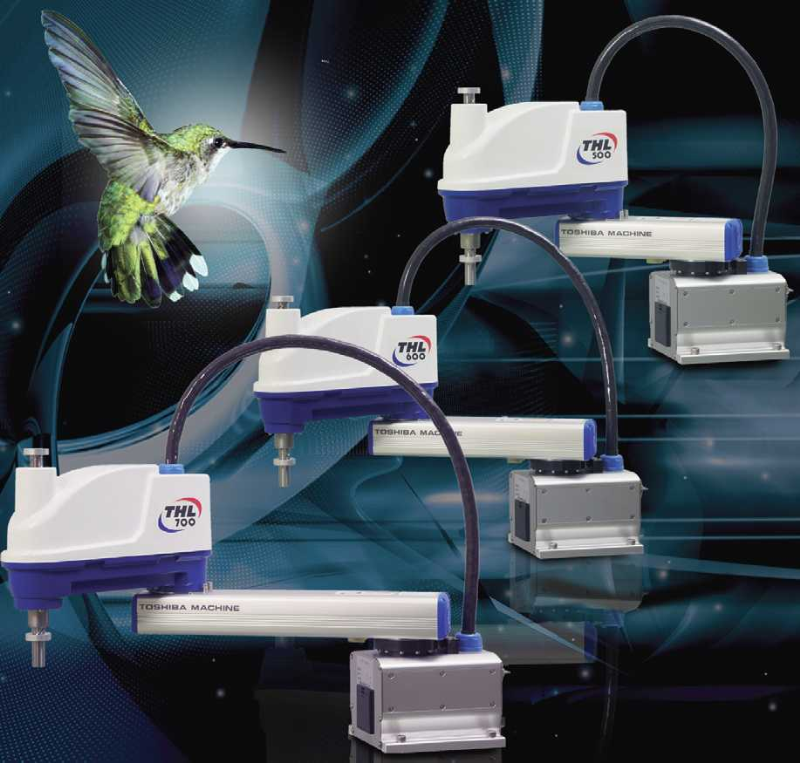 In a quest to build a better mousetrap, Toshiba Machine has taken a long hard look at how to create a new breed of SCARA robots that deliver a host of benefits while at the same time taking a chunk of costs out of the equation
In a quest to build a better mousetrap, Toshiba Machine has taken a long hard look at how to create a new breed of SCARA robots that deliver a host of benefits while at the same time taking a chunk of costs out of the equation
Toshiba Machine has developed a new range of SCARA robots that set new benchmarks for price, performance, mass and low energy consumption. The Toshiba Machine THL models satisfy the growing demand for affordable, flexible automation in applications outside of industries such as packaging, materials handling and welding where robots have been installed for decades.
The THL range represents more than simply low cost lightweight robots. Rather, they are the result of painstaking research and development leading to a radical new design.
The mechanical challenge facing robot designers has always been the ability to marry low mass and low inertia with the necessary rigidity from which high accuracy is attained. Almost always this quest leads to compromise. To ensure rigidity, mass inevitably increases. To compensate for that, oversized servo motors may need to be deployed and position adjustments made via the servo loops. By lowering the mass, smaller motors and simplified gearboxes can be used, which in turn also has the benefit of reducing power consumption and hence reducing the price of the resultant robot. The trick is to get the optimum balance between all of the mitigating factors to ensure none of the machine’s performance is conceded.
Much of the reduction in mass is thanks to the use of lightweight cast aluminium mechanical components that have a series of ribbed sections to provide the rigidity required. As a result of building the body and arm of the robot in this manner, smaller servo motors have been fitted. Moreover, because the lightweight system generates substantially less inertia, and reduced demand for continuous position adjustments, a simplified gearbox has been able to be used.
So, just how successful has Toshiba Machine’s design team been in achieving its objective? Well, the THL range is up to 50 per cent lighter than other Toshiba Machine models and the robots consume 50 per cent less electricity. Performance compares favourably with other models and the new robots feature easier maintenance than previously. The adage might be applied that “if one can make it better and cheaper, it cannot fail.”
The benefit to end users, apart from price, is that the new THL robots can be installed with cheaper, less robust supports with significantly less need for vibration suppression – a major advantage for systems integrators.
Available on 500mm, 600mm and 700mm arm lengths, the next surprising revelation is that all three models have exactly the same price. Toshiba Machine explains that since the only difference between the three robots is the length of the extruded aluminium tube that forms the arm’s main beam, the cost difference is negligible.
Each robot has four axes of movement including ±360° rotational, with a working envelope of ±125° on the first axis and ±145° on axis two. Maximum composite speed using axes one and two is an impressive 6.3m/s for the THL 500, 7.1m/s for the THL 600 and 7.9m/s for the largest THL700. Cycle time, with a 2kg payload, is 0.45s for the THL 500 and THL 600, while the THL 700 is only half a second. Maximum payload is a weighty 10kg for all three models.
The allowable moment of inertia is just 0.2kg/m2 and thanks to the use of absolute encoders repeatability in X-Y is a mere 0.01mm.
The new Toshiba Machine THL robots are distributed and supported throughout Europe by TM Robotics (Europe) Limited. To suit the European markets, the THL robots are controlled by the proven and popular TS3000 controller, which features easy programming, in-built PLC functions and Ethernet connectivity.
An advantage when it comes to integrating automation is the fact that the unit allows complete system control to be handled from the robot controller. Equipped with 64 I/O as standard, but expandable up to 166, the TS3000 controller satisfies even the most demanding production line or manufacturing cell requirements. Impressive process speeds can be attained by taking advantage of the Toshiba Machine controller’s PASS and NOWAIT commands.
Robot programming is simple and conducted via a series of dedicated commands. Furthermore, the TS3000’s Ethernet connectivity makes it simple to share vision data from a single camera across multiple robots, reducing maintenance overheads and installation costs while increasing efficiency.
TM Robotics’ managing director Nigel Smith says: “Industry across Europe, in these times of manufacturing austerity, is crying out for anything that helps it compete. The new low cost THL range certainly helps satisfy that need.
“But,” he adds, “this range of machines is not simply a value engineering exercise to reduce costs. Rather it is a thoroughly thought out remodelling that has resulted in robots that meet completely new and very different design specifications.”
TM Robotics (Europe) Limited
T: 01707 290370

